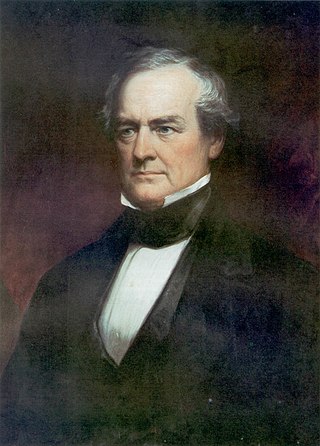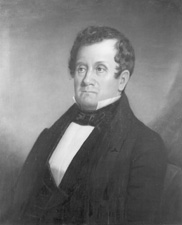| |||||||||||||||||
| |||||||||||||||||
 | |||||||||||||||||
| |||||||||||||||||
| Elections in Georgia |
|---|
 |
The 1845 Georgia gubernatorial election was held on October 6, 1845, to elect the governor of Georgia. The incumbent governor, George W. Crawford, was re-elected to a second term in office. [2]
| |||||||||||||||||
| |||||||||||||||||
 | |||||||||||||||||
| |||||||||||||||||
| Elections in Georgia |
|---|
 |
The 1845 Georgia gubernatorial election was held on October 6, 1845, to elect the governor of Georgia. The incumbent governor, George W. Crawford, was re-elected to a second term in office. [2]
| Party | Candidate | Votes | % | ±% | |
|---|---|---|---|---|---|
| Whig | George W. Crawford | 41,514 | 51.08% | −1.12 | |
| Democratic | Matthew Hall McAllister | 39,763 | 48.92% | +1.12 | |
| Total votes | 81,277 | 100 | |||

George Walker Crawford was a licensed attorney turned politician from Columbia County, Georgia. Crawford was appointed attorney general for the state in 1827, by Governor John Forsyth, serving in that capacity until 1831. Crawford also served five years in the General Assembly's lower house as a representative of Richmond County on a platform of states' rights.

United States gubernatorial elections were held on November 2, 2004, in 11 states and two territories. There was no net gain in seats for either party, as Democrats picked up an open seat in Montana while defeating incumbent Craig Benson in New Hampshire, while Republicans defeated incumbent Joe Kernan in Indiana and won Missouri after Bob Holden lost in the primary. These elections coincided with the presidential election.

The 2006 Illinois gubernatorial election took place on November 7, 2006. Incumbent Democratic Governor Rod Blagojevich won re-election to a second four-year term scheduled to have ended on January 10, 2011. However, Blagojevich did not complete his term, as he was impeached and removed from office in 2009. This was the first election since 1964 that a Democrat was re-elected governor.

United States gubernatorial elections were held on November 5, 2002, in 36 states and two territories. The Republicans won eight seats previously held by the Democrats, as well as the seat previously held by Minnesota governor Jesse Ventura, who was elected on the Reform Party ticket but had since renounced his party affiliation. The Democrats won 10 seats previously held by the Republicans, as well as the seat previously held by Maine governor Angus King, an independent. The elections were held concurrently with the other United States elections of 2002.

The 2010 Georgia gubernatorial election was held on November 2, 2010. Incumbent Republican governor Sonny Perdue was term-limited and unable to seek re-election. Primary elections for the Republican and Democratic parties took place on July 20. Democrats nominated former governor Roy Barnes, and Republicans nominated Representative Nathan Deal following a runoff on August 10. The Libertarian Party also had ballot access and nominated John Monds. Deal won the general election, and took office on January 10, 2011.

The 2002 Georgia gubernatorial election was held on November 5, 2002. Incumbent Democratic governor Roy Barnes sought re-election to a second term as governor. State Senator Sonny Perdue emerged as the Republican nominee from a crowded and hotly contested primary, and he faced off against Barnes, who had faced no opponents in his primary election, in the general election. Though Barnes had been nicknamed "King Roy" due to his unique ability to get his legislative priorities passed, he faced a backlash among Georgia voters due to his proposal to change the state flag from its Confederate design.

The 1974 Georgia gubernatorial election was held on November 5, 1974. Under Georgia's constitution at the time, incumbent Democratic governor Jimmy Carter was ineligible to serve a second consecutive term. He was elected President of the United States in the 1976 presidential election. George Busbee was elected as the 77th Governor of Georgia.

United States gubernatorial elections were held on November 8, 2022, in 36 states and three territories. As most governors serve four-year terms, the last regular gubernatorial elections for all but two of the seats took place in 2018. The gubernatorial elections took place concurrently with several other federal, state, and local elections, as part of the 2022 midterm elections.

The 1851 Alabama gubernatorial election took place on August 4, 1851, in order to elect the governor of Alabama. Democrat Henry W. Collier won his second term with a big majority of the votes.

The 1922 Georgia gubernatorial election took place on November 7, 1922, in order to elect the governor of Georgia.

The 1856 Massachusetts gubernatorial election on November 4. Incumbent Know-Nothing governor Henry J. Gardner was re-elected to a third term. He benefited greatly from a deal with the state's new Republican Party, which agreed not to field a candidate in exchange for Gardner's support of presidential nominee John C. Frémont. With no serious challenger in the field against him, Gardner easily defeated Democrat Erasmus Beach and George W. Gordon, an American Party member running in support of the national ticket.

The 1940 Texas gubernatorial election was held on November 5, 1940.

The 1847 Georgia gubernatorial election was held on October 4, 1847, to elect the governor of Georgia. Democratic candidate George W. Towns won election over Whig challenger Duncan L. Clinch.

The 1849 Georgia gubernatorial election was held on October 1, 1849.

The 1843 Georgia gubernatorial election was held on October 2, 1843, to elect the governor of Georgia. Whig candidate George W. Crawford defeated the Democratic challenger Mark A. Cooper and was elected Governor.

The 1841 Georgia gubernatorial election was held on October 4, 1841, to elect the governor of Georgia. Incumbent Democratic Governor Charles McDonald won re-election defeating Whig State Rights candidate William C. Dawson.

The 1841 New Hampshire gubernatorial election was held on March 9, 1841.

The 1845–46 Massachusetts gubernatorial election consisted of an initial popular election held on November 10, 1845 that was followed by a legislative vote held on January 12, 1846. The ultimate task of electing the governor had been placed before the Massachusetts General Court because no candidate received the majority of the vote required for a candidate to be elected through the popular election. Incumbent Whig Governor George N. Briggs defeated Democratic nominee Isaac Davis, Liberty Party nominee Samuel E. Sewall and Know Nothing nominee Henry Shaw.

The 1990 Georgia lieutenant gubernatorial election was held on November 6, 1990, to elect the lieutenant governor of Georgia, concurrently with the 1990 gubernatorial election, as well as elections to the United States Senate and elections to the United States House of Representatives and various state and local elections. Georgia is one of 21 states that elects its lieutenant governor separately from its governor.

The 1833 Georgia gubernatorial election was held on October 7, 1833, to elect the governor of Georgia. Incumbent Democratic Union Governor Wilson Lumpkin narrowly defeated National Republican Troup nominee Joel Crawford